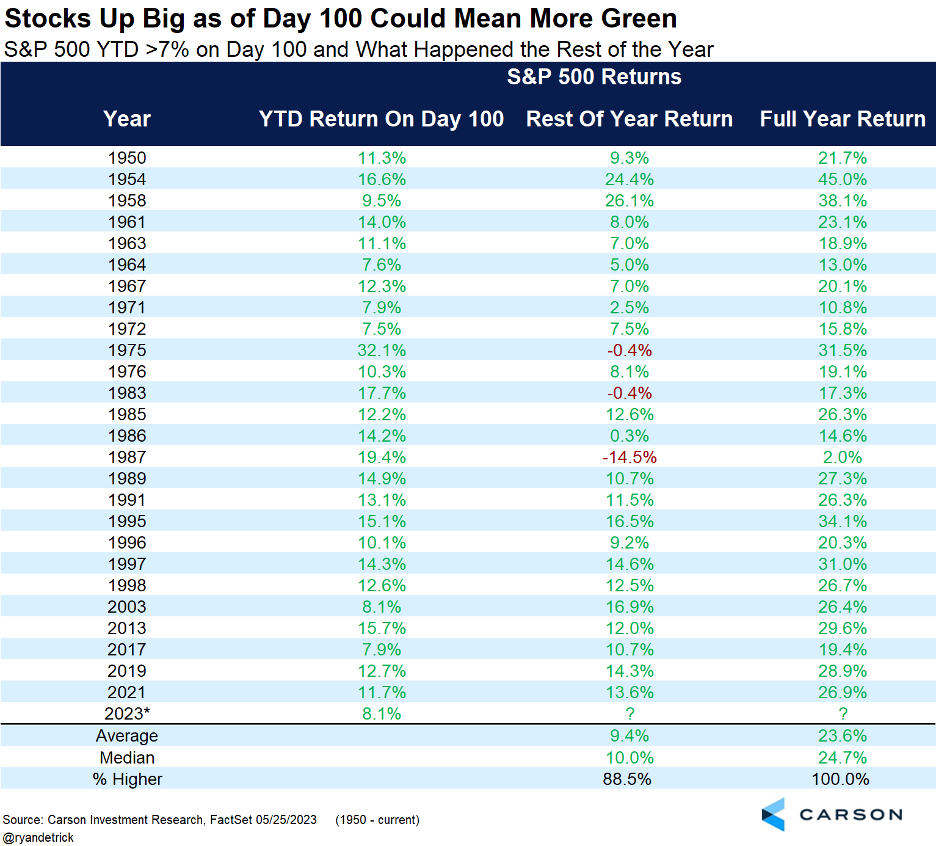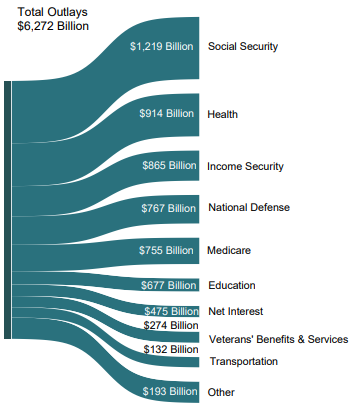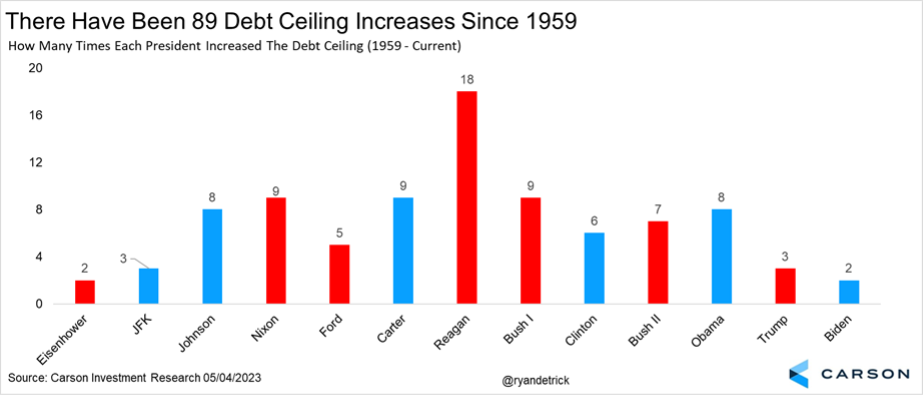The Dow Jones Industrial Average celebrated a birthday last week. The Dow began trading on May 26, 1896, and what a ride it has been. The Dow has weathered depressions, recessions, two 100-year pandemics, wars, famines, inflation, deflation, and many more challenges. However, through good times and bad, the Dow has always come back to new all-time highs. Rough periods have also proven to be good times to invest more at lower prices.
- The Dow marks its 127th birthday.
- Stocks have overcome numerous obstacles and outperformed over the long run.
- Momentum is strong for stocks as the market passes the 100th trading day of the year.
- A debt ceiling deal in Washington, D.C., clears yet another hurdle and reduces uncertainty.
- At Carson, we remain overweight stocks.
Today, the world continues to face challenges: the war in Ukraine, generational inflation, an extremely aggressive Fed, an earnings recession, a likely recession in housing and manufacturing, which are quickly recovering, and more. Markets also faced a vicious bear market in 2022 and underperformance in several sectors in 2023, as large-cap tech companies have accounted for many of the year’s gains. Nonetheless, at Carson, we feel confident that stocks will eventually make new all-time highs yet again, just as they’ve been doing the past 127 years. The ingenuity and flexibility of our country’s economy is second to none, and Americans are valued for their resolve and fortitude. Negative headlines can create anxiety for investors, and we don’t suggest blindly ignoring bad news. But it is important to know that with a long enough time horizon the odds favor a positive return on stocks, an investment in which remains one of the best ways to create wealth and beat inflation.
Last Thursday marked the 100th trading day of the year. The S&P 500 was up 8.1% for one of the better starts to a year. A good start tends to suggest continued higher prices. In fact, when stocks are up more than 7% as of day 100, the rest of the year has typically gained an incredible 89% of the time and added another 9.4% on average. So, it may not be as crazy as it sounds to remain overweight stocks, as we are, and to anticipate higher prices.
We Have a Deal!
Many people have been concerned that Congress would not raise the debt ceiling, which caps the total amount of money the U.S. Treasury can borrow. Not raising the ceiling would potentially lead the U.S. to default on its loans and be unable to pay bills for which Congress has already authorized spending.
At Carson, we’ve been quietly confident that matters will get resolved. The problem is the two parties made things hard for themselves by taking most of the budget off the table, leaving little room for cuts.
The U.S. Treasury chart below shows how the government spent money in fiscal year 2022 (Oct 2021 – Sep 2022).
To summarize, the government spent $6.3 trillion over that year, including the following:
- Social Security and other income benefits: $2.1 trillion (33% of outlays)
- Health care (Medicare, Medicaid, etc.): $1.7 trillion (27%)
- Defense: $767 billion (12%)
Cuts to any of these sectors were ruled out, and that’s 72% of outlays! Excluding interest costs (8%) and veterans’ benefits (4%) leaves just about 16% of the budget to work with, which amounts to about $1 trillion. This is called “discretionary, nondefense spending” and includes items such as national parks and forestry management, law enforcement, scientific research, disaster relief, etc.
The good news is President Joe Biden and Speaker Kevin McCarthy reached a deal to cut this part of the budget in a bill called the Fiscal Responsibility Act.
What’s in the “Deal”?
In exchange for suspending the debt ceiling through January 2025, the two parties agreed to caps on spending. Republicans had originally called for spending caps over the next 10 years. But this deal includes just two years of caps and switches to spending targets, which Congress can choose to heed or ignore.
The deal caps discretionary nondefense spending at fiscal year 2023 levels for the next fiscal year (2024) and for 2025; it also limits spending growth to 1%, which is effectively a cut after accounting for inflation. However, last year Congress approved a huge increase in discretionary spending for 2023 (almost 10% year-over-year). So, spending in this area is going to outpace inflation even with the new caps.
Over the next 10 years, the deal is estimated to result in about $1 trillion in savings from reduced discretionary, nondefense spending, relative to what was expected without the deal. In the immediate term, the deal is estimated to reduce spending by about $55 billion in 2024 and another $81 billion in 2025.
At the same time, defense spending is slated to increase, rising to $886 billion next year, which is in line with what the president had requested in his budget proposal for 2024, and rise to $895 billion in 2025. Spending on veterans’ benefits is also slated to go up, as requested by the president.
Cutting some federal spending during this period of strong employment and high inflation is not a bad idea. If anything, it puts slightly less pressure on the Federal Reserve to continue raising rates to fight inflation.
The actual spending reduction that will occur because of this deal is fairly minor and will not have a significant impact on the economy. An analysis from Goldman suggests the deal will likely reduce spending by 0.1-0.2% of GDP in 2024 and 2025.
What Next?
The next big step will be passing the deal through Congress. The House is slated to vote on May 31 and the Senate on June 2. Time is short since the Treasury will likely run out of money on June 5.
Fair warning: Expect a lot of noise from both sides saying this is a horrible deal.
Ultimately, President Biden and Speaker McCarthy will probably be able to twist enough arms to approve the deal, which will require a bipartisan vote.
As we pointed out in a previous article, we expect the debt ceiling to be increased (suspended) yet again, for the 90th time since 1959.
All in all, a lot of uncertainty has been reduced, even though there will be a minor reduction in federal government spending over the next couple of years. A big positive is we don’t have to worry about the debt ceiling until 2025. Welcome news indeed.
This newsletter was written and produced by CWM, LLC. Content in this material is for general information only and not intended to provide specific advice or recommendations for any individual. All performance referenced is historical and is no guarantee of future results. All indices are unmanaged and may not be invested into directly. The views stated in this letter are not necessarily the opinion of any other named entity and should not be construed directly or indirectly as an offer to buy or sell any securities mentioned herein. Due to volatility within the markets mentioned, opinions are subject to change without notice. Information is based on sources believed to be reliable; however, their accuracy or completeness cannot be guaranteed. Past performance does not guarantee future results.
S&P 500 – A capitalization-weighted index of 500 stocks designed to measure performance of the broad domestic economy through changes in the aggregate market value of 500 stocks representing all major industries.
The NASDAQ 100 Index is a stock index of the 100 largest companies by market capitalization traded on NASDAQ Stock Market. The NASDAQ 100 Index includes publicly-traded companies from most sectors in the global economy, the major exception being financial services.
A diversified portfolio does not assure a profit or protect against loss in a declining market.
Compliance Case # 01780381





